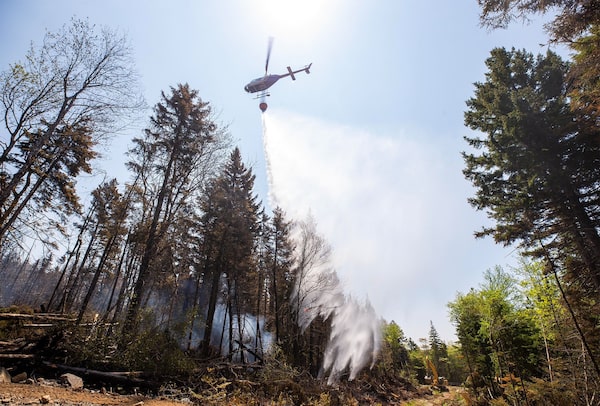
A helicopter drops water on a hotspot behind Yankeetown Road as excavator makes a fire break in the Tantallon wildfire near Halifax, on June 1.Supplied/AFP/Getty Images
Benjamin McMillan, his wife and newborn baby drove down Highway 103 to Tantallon on Friday, dreading what they might find. A wildfire evacuation order had just been lifted for their community in the suburbs of Halifax, and Mr. McMillan was unsure whether the blaze, which had destroyed at least 150 homes in the area, had jumped Hammonds Plains Road to reach their mid-century split level on Stillwater Lake.
All week, he’d been watching the moving swirl of grey smoke in satellite images from NASA’s Fire Information Resource Management System, hopeful that his family would still have a home. If they did, would it be covered in ash? Would the trees be charred?
Many others were coping with the same harrowing, uncertain feeling. More than 16,000 people were forced last week to evacuate the wooded suburban communities of Tantallon and Hammonds Plains, northwest of Halifax. Many have since been awaiting news that could affect the next several years of their lives.
“It was kind of eerie,” Mr. McMillan said, describing the drive into the area. “Much of the subdivision was dark. It looked as if everyone was away on vacation.” The air was still thick with smoke, and he and his wife wondered whether the air quality would be safe for their children, especially Violet, the baby, who was in her covered carrier in the back seat.
Wildfire activity this spring ‘unprecedented,’ federal officials say
Their boys, Finley, 5, and Dashiell, 4, were staying with their grandfather in Tatamagouche, N.S.
The wildfire, which was fed by a spate of hot, dry weather and gusting winds last week, is now considered under control. As of Monday night it covered 950 hectares. It is one of five active wildfires in the province. Another of them, the largest in Nova Scotia’s history, was still out of control on Monday in the Barrington Lake area, in the province’s southwest.
About 4,900 people remain displaced in the Halifax area, a quarter of the number at the height of the evacuations.
On Friday, the city extended its local state of emergency for another week to fast-track the construction of two new evacuation routes in the subdivisions that were affected by wildfires – a plan Pam Lovelace, the Halifax regional councillor for Hammonds Plains, said she brought forward in 2021. She said the city had been awaiting a report on the matter.
On Monday, heavy equipment cut down trees and spread gravel to build the new roads, she said.
“If this rain stops … and we end up having another wildfire, we want people to be able to evacuate quickly, but we also want people to feel safe,” Ms. Lovelace said. She herself was evacuated from her home in the community of Pockwock.
Mr. McMillan received his evacuation alert on May 28. Unlike others, who sat in traffic because of the lack of evacuation routes, he and his family got out fairly quickly.
They were eating supper – hot dogs and Kraft Dinner cooked on a Coleman stove, because the power was out – when the alert screeched on their phones. They grabbed diapers, wipes and kids’ clothes, buckled up the children and squeezed everything into their Toyota Corolla, including three carriers for their cats, Brie, Pip and Sebastien. They left their two rescue dogs, Roadie and Daisy, behind. (A friend later talked her way past a checkpoint to retrieve them.)
Pulling up to his family’s driveway six days later, Mr. McMillan breathed a sigh of relief. There was no ash. Their house was intact. And the budding leaves had opened further on the branches of their trees. Inside the home, the air smelled like someone had snuffed out a candle.
“It was just a verdant little paradise,” Mr. McMillan said. “We were like ‘Wow, we really lucked out.’”